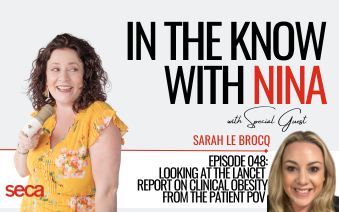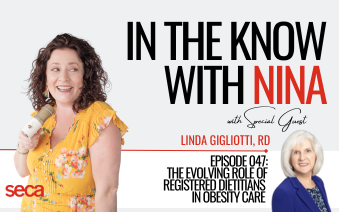Highlights from the ASMBS 40th Annual Meeting: Transformative Insights and Future Directions
Highlights from the ASMBS 40th Annual Meeting: Transformative Insights and Future Directions
The Butterfly Effect
This year marked the 40th Annual Meeting of the American Society for Metabolic and Bariatric Surgery in San Diego! The theme focused on how metabolic bariatric surgery can create transformative, long-term changes, and emphasized our deeply interconnected world, where even small occurrences can influence a much larger complex system.
The IH Keynote speaker, Ted Adams, PhD, discussed the “butterfly effect” in the context of metabolic bariatric surgery (MBS). He highlighted the potential of new obesity medications as successful adjunct therapies, noting a 10-fold increase in circulating GLP-1 levels post-surgery. Adams speculated on how future discoveries might predict individual patient success. He also emphasized the significant impact frontline providers can have, quoting Margaret Mead: “Never doubt that a small group of thoughtful, committed citizens (or caregivers!) can change the world; indeed, it’s the only thing that ever has.”
Leadership & Initiatives
Dr. Ann Rogers, the next ASMBS president, spoke about her plans to reduce or eliminate weight bias. She emphasized advocacy, policy, and public education on weight bias and obesity stigma. As a long-term advocate with the Obesity Action Coalition, I am thrilled to see our national association prioritizing this issue.
Check out my podcast episode on In the Know with Nina, where I interview Dr. Ann Rogers about her plans to eliminate weight bias.
Focus on Exercise & Body Composition
This year was the first for a pre-conference course all about exercise, “Walking the walk, Talking the Talk: Team Approaches to Physical Activity”, and it was well received by a large audience eager to learn how to help patients implement more physical activity!
I was thrilled to see Dr. Ricardo Rosero giving a talk on ‘Body Composition & Metabolism’ starting with a nice history and timeline of body composition assessment methods, looking at the 2, 3 and 4 compartment models, gold standards for each of the body composition parameters, and how to use these evaluation methods in reality considering factors like cost, safety, replicability, precision, duration, and functionality of DXA, US, and BIA.
He shared a 2020 study from Bosy-Westphal & Muller that concludes: “Considering the overwhelming evidence for the protective function of muscle mass and adipose tissue expandability, the definition and diagnosis of obesity based on “adiposity/overfat” and characterized by BMI does not represent a meaningful outcome. In the era of precision medicine, we should avoid using BMI our goal should be to characterize patients and target interventions based on individual body composition phenotypes”.
Click to read the study from Bosy-Westphal & Muller
One of the visuals I liked most, was a 2×2 plot looking at the dimensions of low to high adiposity, and low to high muscle mass along with the location of adipose tissue and muscle quality (see image below). He stressed that the metabolic effects depend on the quantity and distribution of muscle and adipose tissue.
Interdisciplinary Approach
The Interdisciplinary team approach to exercise was most appreciated, and David Creel did a great job connecting the dots for us on this approach and how to understand the research in the context of an individual patient in front of you. He shared a great article by Gil et al., 2021 with some compelling evidence to incorporate exercise into the recovery algorithm for bariatric patients to counter the post-surgical loss of muscle mass and function.
Check it out here!
I was thrilled to see some of the presenters in this session talking about how helpful they find that body composition analysis is in their practice! Exercise Physiologist, Dr. Angela Glauser finds that the “beautiful” seca BIA printouts that show segmental skeletal muscle mass distribution, body fat percentage, and visceral fat show them how the interventions are working! Patients resonate with a ‘numbers don’t lie’ mentality and find many positive things that they don’t see when just looking at weight alone!
Physical Therapist, Dr. Kathy Ling has patients who say their goal is not to be “Skinny and Weak”, and that they are motivated by learning about how without exercise they could be at risk of losing skeletal muscle mass. Program Coordinator, Carah Horn, RN, showed how her interdisciplinary team uses their seca BIA device in conjunction with sports medicine and athletic trainers to help patients at all time points before and after surgery. They look at their body composition analysis to reinforce the message that “weight loss is not just about the weight” and when patients are at a plateau with weight, they may be able to see that their muscle mass is increasing. The team uses body comp data to show the patients tangible evidence of change, and how the treatments are targeting the disease, not just the number on the scale!
Engaging the Next Generation
Another highlight was participating in the 1st, and definitely annual, ASMBS Pathway Program for high school students interested in healthcare careers. I was on a panel to talk to them about understanding obesity as a disease, and of course, the importance of people first language! I can only imagine if we all learned this as teens how different our culture would be today! It was really heartwarming to see their passion at such a young age and be able to help them consider careers in the interdisciplinary care of people with obesity! I was impressed that they already have been hearing about and thinking about how to define and assess obesity in other ways than weight – I got to show them all about bioimpedance and body composition assessment at the exhibit booth, and give them some personalized data to consider in a holistic approach! We also had a rock star panel of experts with all combinations of nutrition, exercise, nursing, medical, and psychological degrees talking about our winding paths to land in our careers and share advice and wisdom with the students!
Overall, the 40th ASMBS Annual Meeting was a platform for sharing research and practical applications while inspiring our future generation in the field of metabolic and bariatric surgery. The networking and connections we made outside the educational sessions were just as important! It was great to reconnect with so many of my bariatric surgery friends, and meet so many more people who are new in the field, working to optimize their surgical and wrap-around comprehensive programs by adding body composition to their offerings. I loved the enthusiasm for body composition at this meeting, and hearing how our current customers are finding it to be practical and valuable!
Recommended Episodes
Episode 49: Wellness, Weight Management, and White Lotus
In this episode, Dr. Nina Crowley and Jeannie Boyer, RD, explore body composition analysis, its role in holistic obesity care, and the shift from traditional weight loss models to personalized health strategies. They also break down White Lotus’s take on body composition! Listen now for a fresh perspective.
Watch episodeEpisode 48: Looking at the Lancet Report on Clinical Obesity from the Patient POV
Sarah Le Brocq joins In the Know with Nina to discuss the Lancet Commission’s recommendations for redefining obesity diagnosis. The conversation explores moving beyond BMI, using body composition analysis, and addressing treatment access challenges. Hear the patient perspective on how these changes could impact obesity care. Listen now.
Watch episodeExplore the evolving role of Registered Dietitians in obesity care with Dr. Nina Crowley and RD Linda Gigliotti. This episode dives into Incretin-Based Therapies, nutrition counseling, and body composition monitoring to support patient-centered care.
Watch episodeseca north america
Medical Measuring Systems and Scales since 1840
13601 Benson AvenueChino, CA 91710
USA
seca Service
As the world leader in medical scales, we also offer you first-class service. Together with our branches, partners and dealers, seca offers a worldwide service network that ensures our products work troublefree.
All rights reserved seca 2023


